
Fire detection system with Arduino

Presentation of fire detection system
A fire detection system is a system that detects the presence of fire and raises an alarm to alert people in the building or area of the potential danger. There are several types of fire detection systems that can be used, each with its own advantages and disadvantages.
- Smoke detectors: These are the most common type of fire detection system. They use either ionization or photoelectric sensors to detect the presence of smoke and sound an alarm.
- Heat detectors: These systems detect the presence of heat and can be used in areas where smoke detectors may not be suitable, such as kitchens or other areas where there is a lot of smoke or steam.
- Flame detectors: These systems use optical sensors to detect the presence of a flame and can be used in areas where there is a risk of fire from flammable liquids or gases.
- Combination systems: These systems use a combination of smoke, heat, and flame detectors to provide optimal fire detection coverage.
- Addressable systems: These are the most advanced type of fire detection systems. They can detect and locate the source of a fire, making it easier for the fire department to quickly locate and extinguish the fire.
These systems can be connected to alarm panels, which sound an alarm, send notifications, and can notify the local fire department. Many fire detection systems can also be integrated with building management systems and can control other building systems such as HVAC, lighting, and elevators to help contain a fire.
All the above systems can be integrated with microcontroller like Arduino, so that the system can take automated actions based on the sensor data.
A fire detection system with Arduino is a system that uses an Arduino microcontroller to detect the presence of fire and raise an alarm. The Arduino board can be used to read input from various types of fire sensors, such as smoke detectors, heat detectors, or flame detectors, and can be programmed to perform specific actions when a fire is detected.
To build a fire detection system with Arduino, the following steps can be followed:
- Connect fire sensors: Depending on the desired functionality, various fire sensors can be connected to the Arduino board, such as a smoke detector, a heat detector, or a flame detector.
- Write the code: Using the Arduino programming language, the code can be written to read the sensor data, perform calculations, and control the output devices such as the alarm, LED or buzzer.
- Upload the code: The code can be uploaded to the Arduino board using a USB cable and the Arduino development software.
- Connect the output devices: The alarm, LED or buzzer can be connected to the Arduino board, and can be controlled by the Arduino board to sound an alarm, turn on a light, or give a visual indication when a fire is detected.
- Power supply: Finally, the Arduino board and the other electronic components can be powered through a power supply or a battery.
With this setup, the fire detection system can be controlled by the Arduino board and can be programmed to perform specific actions when a fire is detected, such as sounding an alarm, sending notifications, or controlling other building systems to help contain a fire.
It is important to note that, Fire detection system should be designed in such a way that it can detect fire in the early stage, raise an alarm and notify the fire department and other emergency services in case of a fire, so that the fire can be contained and extinguished as quickly as possible.
Purpose of this project:
In this project a fire detection system will be built with Arduino. It mainly uses a KY-026 flame sensor, buzzer and LED.
When the flame sensor detects a fire, the Arduino board orders the buzzer to ring and the red LED to light up.
Necessary components
Arduino UNO

The Arduino UNO is a microcontroller board based on the ATmega328P. It has 14 digital input/output pins, 6 analog inputs, a 16 MHz quartz crystal, a USB connection, a power jack, an ICSP header, and a reset button. It is the most popular and widely used board among the Arduino boards.
The Arduino UNO can be programmed using the Arduino programming language, which is based on C++. It uses a simple and intuitive programming environment, making it easy for beginners to get started with microcontroller programming.
The Arduino UNO can be connected to various sensors and actuators to control different devices and perform different tasks. For example, it can be used to control motors, read data from sensors, display information on an LCD screen, and communicate with other devices via serial communication protocols such as I2C and SPI.
The Arduino UNO can also be powered by a USB cable or an external power supply, making it easy to use in a wide range of projects and applications. It’s compatible with a wide range of shields (expansion boards) that adds functionality to the board, such as Ethernet, WiFi, and Bluetooth, and it’s widely supported by a strong and active community, which provides a lot of tutorials, examples and libraries to help users to get the most of the board.
KY-026 sensor

The KY-026 sensor is a flame sensor module that is often used with Arduino and other microcontroller-based projects. It detects infrared signals in the range of 760nm to 1100nm, which are typically emitted by fire flames. The sensor module includes a photodiode which is sensitive to infrared signals and a comparator circuit that generates a digital output when the infrared signals exceed a certain threshold.
The KY-026 sensor typically has four pins: VCC, GND, AO and DO. The VCC pin is connected to a power source (usually 3.3V or 5V), the GND pin is connected to ground, the AO pin is the analog output pin and the DO pin is the digital output pin. The digital output pin sends a high signal when the module detects a flame and a low signal when no flame is detected.
The KY-026 sensor can be used to detect flames in a wide range of applications such as fire alarms, gas detectors, and other safety systems. It can be used as a part of the fire detection system, where it can detect the flame and raise an alarm or notify the fire department.
In Arduino, the digitalRead() function can be used to read the output of the sensor, and the values can be used to make decision and raise an alarm or notify the fire department.
Buzzer

A buzzer is an electronic device that produces a sound when an alternating current is applied to it. It is used for a variety of purposes, such as in alarms, timers, and other devices that need to produce an audible signal.
1 resistance of 220Ω
![]()
Resistance is the measure of a material’s ability to oppose the flow of electric current. It is measured in units of ohms (Ω). The resistance of a material is determined by its composition and temperature, and can be affected by changes in temperature and the presence of impurities.
1 red LED
![]()
A red LED (Light Emitting Diode) is a type of semiconductor device that emits light when a current is passed through it. LEDs are made of a material called a semiconductor, which is a type of material that has electrical properties that fall between those of a conductor and an insulator. When a current is passed through an LED, it causes the electrons in the semiconductor to become excited and release energy in the form of light.
connecting wires

Connecting wires are used to connect various components in an electronic circuit. They allow for the transfer of electricity, data, or signals between different devices and components.
When connecting wires to an Arduino or other microcontroller, it is important to pay attention to the correct pinout. The pinout refers to the arrangement of pins on the microcontroller and the corresponding function of each pin. The Arduino pinout can be found in the documentation provided by the manufacturer, or in various resources available online.
test plate

A test plate, also known as a test jig, is a device used to test electronic circuits and components. It is a board or plate that has been designed to hold and connect various components and devices in a specific configuration, allowing for the easy testing and measurement of their performance.
A test plate can be used to test various types of electronic circuits and components, such as microcontrollers, sensors, and actuators. It typically includes connectors and sockets for connecting wires, power supply and measurement devices such as multimeters, oscilloscopes, and power supplies.
Mounting
To make the assembly, we can connect:
- 2 (+) red LED and buzzer terminals to pin 4 of Arduino
- 2 (-) red LED and buzzer terminals to Arduino GND pin
- DO pin of KY-026 sensor to pin A0 of Arduino.
- VCC pin of KY-026 sensor to 3.3V pin of Arduino.
- GND pin of KY-026 sensor to GND pin of Arduino .

Program
The Fire Detection System program is as follows:
|
1 2 3 4 5 6 7 8 9 10 11 12 13 14 15 16 17 18 19 20 21 22 |
int digitalPin = 4; int analogPin = A0; // KY-026 analog interface int digitalVal; // digital readings int analogVal; //analog readings void setup() { pinMode(digitalPin, OUTPUT); digitalWrite(digitalPin, LOW); } void loop() { // Read the analog interface analogVal = analogRead(analogPin); if (analogVal<=11){ // the KY-026 sensor detects a fire digitalWrite(digitalPin, HIGH); //LED lights up and buzzer rings } else { // sinon digitalWrite(digitalPin, LOW); // LED goes out and buzzer stops ringing } delay(100); } |



















